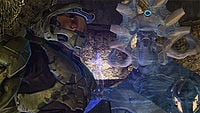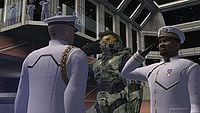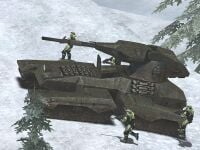SPARTAN-II program
From Halopedia, the Halo wiki
Project: SPARTAN-II is part of the ongoing Spartan Program. Headed by Dr. Catherine Halsey of ONI, Section 3, and Chief Petty Officer Mendez of the UNSC armed forces, the program turned ordinary civilian children into the most capable fighting force that has ever been seen in battle. The Spartan II Program had its roots its predecessor the Spartan 1 Program which started in 2494. In 2517, the children selected for the program were chosen based on their strength, height, weight, and various other criteria on which would serve the SPARTAN-II project best. These children were then taken to Reach where they began their physical training by CPO Mendez at 5-7 years of age. They trained as Marines, and after two years, they began their treatments for physical augmentation. Some of these augmentations, which caused about half of them to die and a few others were discharged from military service due to horrible side effects caused by the procedure. Those who recovered completely went on to receive further training and went on to become the current team of Spartans.
Project SPARTAN-II was created in conjunction with Project MJOLNIR so that, once combined, the Spartans in their MJOLNIR armor would be the ultimate soldiers.
Purpose of Project SPARTAN-II
The future of the UNSC looked bleak, as of 2525. ONI projections of the outer colonies concluded that their extreme instability would result in massive rebellion within twenty years unless drastic military action was taken. The SPARTAN-II soldiers were designed to be a perfect pinpoint strike force, preventing massive civilian casualties and perhaps, even a civil war, should rebellions surface. They were designed to quell insurrection.
Ironically, the appearance of The Covenant reversed their mission. After the emergence of the new threat, the Spartan soldiers fought to save every human life they possibly could from its clutches. They, along with humanity fought valiantly, but their numbers have slowly dwindled. Even though the Spartans were supersoldiers, there were still only so many of them compared to the hordes of Covenant they face. This may have prompted the UNSC to start a new generation of supersoldiers codenamed Spartan III.
Before The Battle of Reach and the destruction of the UNSC Pillar of Autumn at Installation 04, the UNSC planned to have the Spartans capture a Covenant ship, in order to locate High Charity. There, they would capture a Prophet, and force an end to the war. They did not know that High Charity was a mobile station, rather than a planet in a fixed system of space. That mission was aborted after Reach fell and most of the Spartans were assumed killed. Even in posession of the Ascendant Justice, it was a virtual suicide mission in light of the circumstances. The Master Chief was convinced to abort the mission. Apparently it was a good idea, because according to Dr. Halsey's profile on Covenant society, the capture of a Prophet would escalate the war.
Later, when the Master Chief had an opportunity to capture the High Prophet of Regret, he did not. There are several proposed reasons for this. First, he had recieved a direct order from Commander Miranda Keyes to kill the Prophet. Second, the Covenant knew the location of Earth and there was no place left for the humans to hold such an important prisoner. Third, the Chief had no backup and it would have been extremely difficult for him to capture the Prophet with its Honor Guard surrounding him and hundreds more Covenant soldiers en route.
Augmentation Procedures
- Main article: Spartan Augmentation Procedures
Admiral Ysionris Jeromi of the research station Hopeful documented the following experimental procedures on Bonobo Chimpanzees. These operations were later performed on the Spartan soldiers:
- Carbide ceramic ossification
- Muscular enhancement injections
- Catalytic thyroid implant
- Occipital capillary reversal
- Superconducting fabrication of neural dendrites
| |||||||||||||||||


